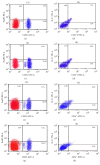Scolopendra subspinipes mutilans L. Koch Ameliorates Rheumatic Heart Disease by Affecting Relative Percentages of CD4+CD25+FoxP3 Treg and CD4+IL17 T Cells
- PMID: 31379962
- PMCID: PMC6662451
- DOI: 10.1155/2019/4674190
Scolopendra subspinipes mutilans L. Koch Ameliorates Rheumatic Heart Disease by Affecting Relative Percentages of CD4+CD25+FoxP3 Treg and CD4+IL17 T Cells
Retraction in
-
Retracted: Scolopendra subspinipes mutilans L. Koch Ameliorates Rheumatic Heart Disease by Affecting Relative Percentages of CD4+CD25+FoxP3 Treg and CD4+IL17 T Cells.Evid Based Complement Alternat Med. 2021 Nov 3;2021:9816302. doi: 10.1155/2021/9816302. eCollection 2021. Evid Based Complement Alternat Med. 2021. PMID: 34777539 Free PMC article.
Abstract
(Scolopendra subspinipes mutilans L. Koch. (SSLK) helps reduce the risk of coronary heart disease (CHD) but its effects on rheumatic heart disease (RHD) patients remain unclear. 80 RHD patients were recruited and randomly assigned into SG (to receive SSLK treatment) and CG (to receive placebo) groups, and the intervention lasted for 3 months. The following cardiac indexes were measured, including mean arterial pressure (MAP), heart rate (HR), central venous pressure (CVP), blood lactate, fatigue, shortness of breath, palpitation, and chest pain. ELISA kits were used to analyze creatine kinase isoenzyme (CK-MB), serum troponin T (cTnT), CRP, IL-1β, IL-6, and TNF-α, malondialdehyde (MDA), and superoxide dismutase (SOD). Relative percentages of CD4+CD25+FoxP3 regulatory (Treg) and CD4+IL-17 T cells were measured using flow cytometry. After 3-month therapy, SSLK intervention improved MAP, HR, CVP, fatigue, palpitation, and shortness breath of CHD patients, reduced the levels of blood lactate, CK-MB, cTnT, CRP, IL-1β, IL-6, TNF-α, MDA, and increased SOD level (p < 0.05). Meanwhile, SSLK treatment increased the percentages of CD4+CD25+FoxP3 Treg cells and reduced relative percentages of CD4+IL-17 T cells in a dose-dependent way (p < 0.05). Relative percentage of CD4+CD25+FoxP3 Treg cells had negative relationship while CD4+IL17 T cells had positive relationship with CK-MB, cTnT, CRP, and TNF-a (p < 0.01). SSLK ameliorated RHD by affecting the balance of CD4+CD25+FoxP3 Treg and CD4+IL17 T cells.
Conflict of interest statement
The authors declare that they have no competing interests.
Figures






Similar articles
-
Retracted: Scolopendra subspinipes mutilans L. Koch Ameliorates Rheumatic Heart Disease by Affecting Relative Percentages of CD4+CD25+FoxP3 Treg and CD4+IL17 T Cells.Evid Based Complement Alternat Med. 2021 Nov 3;2021:9816302. doi: 10.1155/2021/9816302. eCollection 2021. Evid Based Complement Alternat Med. 2021. PMID: 34777539 Free PMC article.
-
Decreased proportions of CD4 + IL17+/CD4 + CD25 + CD127- and CD4 + IL17+/CD4 + CD25 + CD127 - FoxP3+ T cells in children with autoimmune thyroid diseases (.).Autoimmunity. 2016 Aug;49(5):320-8. doi: 10.1080/08916934.2016.1183654. Epub 2016 May 20. Autoimmunity. 2016. PMID: 27206624
-
Astragalus Oral Solution Ameliorates Allergic Asthma in Children by Regulating Relative Contents of CD4+CD25highCD127low Treg Cells.Front Pediatr. 2018 Sep 20;6:255. doi: 10.3389/fped.2018.00255. eCollection 2018. Front Pediatr. 2018. PMID: 30294594 Free PMC article.
-
[Regulation effect of scorpio and scolopendra on CD4 + CD25 + FoxP3 + Treg cell in peripheral blood from rats with collagen-induced arthritis (CIA)].Zhong Yao Cai. 2012 Apr;35(4):525-8. Zhong Yao Cai. 2012. PMID: 23019895 Chinese.
-
Expression of Th17 and CD4+ CD25+ T regulatory cells in peripheral blood of acute leukemia patients and their prognostic significance.Pak J Pharm Sci. 2016 Nov;29(6 Suppl):2405-2410. Pak J Pharm Sci. 2016. PMID: 28167485
Cited by
-
Deficiency of Tregs in hypertension-associated left ventricular hypertrophy.J Clin Hypertens (Greenwich). 2023 Jun;25(6):562-572. doi: 10.1111/jch.14660. Epub 2023 May 17. J Clin Hypertens (Greenwich). 2023. PMID: 37196041 Free PMC article.
-
Role of Treg cell subsets in cardiovascular disease pathogenesis and potential therapeutic targets.Front Immunol. 2024 Mar 15;15:1331609. doi: 10.3389/fimmu.2024.1331609. eCollection 2024. Front Immunol. 2024. PMID: 38558816 Free PMC article. Review.
-
Identification of Immune-Related Genes in Patients with Acute Myocardial Infarction Using Machine Learning Methods.J Inflamm Res. 2022 Jun 3;15:3305-3321. doi: 10.2147/JIR.S360498. eCollection 2022. J Inflamm Res. 2022. PMID: 35692951 Free PMC article.
-
Zhijing powder manages blood pressure by regulating PI3K/AKT signal pathway in hypertensive rats.Heliyon. 2023 Jan 2;9(1):e12777. doi: 10.1016/j.heliyon.2022.e12777. eCollection 2023 Jan. Heliyon. 2023. PMID: 36685421 Free PMC article.
-
Retracted: Scolopendra subspinipes mutilans L. Koch Ameliorates Rheumatic Heart Disease by Affecting Relative Percentages of CD4+CD25+FoxP3 Treg and CD4+IL17 T Cells.Evid Based Complement Alternat Med. 2021 Nov 3;2021:9816302. doi: 10.1155/2021/9816302. eCollection 2021. Evid Based Complement Alternat Med. 2021. PMID: 34777539 Free PMC article.
References
-
- Makrexeni Z. M., Pepeta L. Clinical presentation and outcomes of patients with acute rheumatic fever and rheumatic heart disease seen at a tertiary hospital setting in Port Elizabeth, South Africa. Cardiovascular Journal of Africa. 2017;28(4):248–250. doi: 10.5830/CVJA-2017-019. - DOI - PMC - PubMed
-
- Abdullahi U., Kana S., Yakasai M., et al. Update on rheumatic heart disease in Kano: data from the Aminu Kano Teaching Hospital echocardiography registry. Nigerian Journal of Basic and Applied Sciences. 2017;14(2):127–130. doi: 10.4103/njbcs.njbcs_17_17. - DOI
Publication types
LinkOut - more resources
Full Text Sources
Research Materials
Miscellaneous

